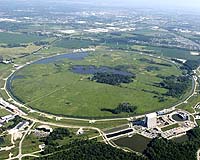 |
Geneva (AFP) Dec 18, 2009 Scientists have switched the world's most powerful atom-smasher to standby for two and a half months, the European Organisation for Nuclear Research (CERN) said on Friday. The Large Hadron Collider (LHC) ended the year "in style", CERN said, achieving more than a million particle collisions in the last two weeks and accelerating proton beams to energy levels never reached before. CERN said the LHC would be restarted in February after a short technical stop to prepare it for collisions at even higher energy levels. "Commissioning work for higher energies will be carried out in January, along with necessary adaptations to the hardware and software of the protections systems," CERN said in a statement. The 3.9 billion-euro (5.6 billion dollar) collider was relaunched in November after 14 months out of action because of an electrical fault. Scientists hope to use the collider -- inside a 27-kilometre (16.8-mile) tunnel straddling the Franco-Swiss border -- to understand the origins of the universe by recreating the conditions that followed the Big Bang. So far, the LHC has achieved collisions at an energy level of 2.36 teraelectronvolts (TeV), and CERN wants to reach 7.0 TeV to try to recreate the conditions of the Big Bang. Before the LHC experiment, no particle accelerator had exceeded 0.98 TeV. One TeV is the equivalent to the energy of a flying mosquito. The LHC aims to resolve physics problems including "dark matter" and "dark energy", thought to account for 96 percent of the cosmos. The scientists' Holy Grail is to find a theorised component called the Higgs Boson, which would explain how particles acquire mass. Share This Article With Planet Earth
Related Links Understanding Time and Space
 LHC Produces First Physics Results
LHC Produces First Physics ResultsHeidelberg, Germany (SPX) Dec 16, 2009 The first paper on proton collisions in the CERN Large Hadron Collider (LHC) - designed to provide the highest energy ever explored with particle accelerators - is published online this week in Springer's European Physical Journal C. On 23 November 2009, during the early commissioning of the CERN (European Organization for Nuclear Research) LHC - which was built in the circular tunnel of ... read more |
|
| The content herein, unless otherwise known to be public domain, are Copyright 1995-2009 - SpaceDaily. AFP and UPI Wire Stories are copyright Agence France-Presse and United Press International. ESA Portal Reports are copyright European Space Agency. All NASA sourced material is public domain. Additional copyrights may apply in whole or part to other bona fide parties. Advertising does not imply endorsement,agreement or approval of any opinions, statements or information provided by SpaceDaily on any Web page published or hosted by SpaceDaily. Privacy Statement |